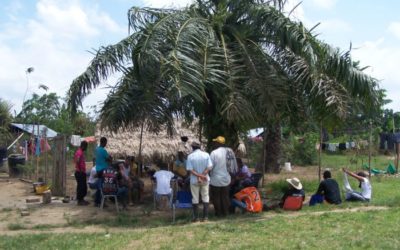Threats and killings coupled with the weak implementation of flawed legislation are scuppering the Colombian government’s promise to return millions of hectares of land illegally snatched from peasant farmers, Indigenous People and Afro-descendant communities, said Amnesty International today.
In a new report A land title is not enough: Ensuring sustainable land restitution in Colombia, Amnesty International explores how the Victims and Land Restitution Law (Law 1448), implemented in 2012, is failing the vast majority of people whose lands were stolen. Many have been unable to return home due to ongoing threats of violence and the slowness of the restitution process.
“Colombia has one of the highest levels of forced displacement in the world and it is patently clear that the authorities are not doing enough to ensure that stolen lands are effectively returned to their rightful occupants,” said Marcelo Pollack, Colombia Researcher, Amnesty International.
“Handing over a land title and sending people on their way is not enough. The Colombian authorities must speed up the bureaucratic processes and ensure physical and financial security for those returning. All those suspected of criminal responsibility for forced displacement must be brought to trial.”
Almost six million people (13% of the population) have been forcibly displaced, mostly by paramilitaries and the security forces, over the course of Colombia’s bloody armed conflict. An estimated eight million hectares have been illegally acquired, an area larger than Costa Rica, often to the benefit of powerful economic interests.
While Amnesty International welcomed the introduction of the law, failures to effectively implement it and to address weaknesses in the legislation, have meant that the government is failing to respect victims’ right to an effective remedy.
Even when land titles are granted under Law 1448, threats of violence and a lack of basic infrastructure and financial support are stopping people from returning home.
Violence
Those that try to return home, as well as those representing them and state officials involved in the restitution process, face serious threats, violence and even death, mostly at the hands of paramilitary groups. By the end of August 2014, the Office of the Attorney General was investigating at least 35 killings of individuals who were involved in the land restitution process. The actual number of those killed, however, is likely to be much higher.
“How can anyone be expected to go home knowing that the same people that forcibly displaced them in the first place, and threatened and killed their friends and family, could be waiting for them? If the government does not address the serious and widespread violence perpetrated against those who try to return home and those accompanying them, then all its policies and laws will be nothing more than empty gestures,” said Marcelo Pollack.
Corporate exploitation
The armed conflict has repeatedly been used as a means by powerful national and international corporate giants to advance, consolidate and protect their economic interests, including through the illegal acquisition of large swathes of land. However, to date the land restitution process has focused largely on relatively easy, small-scale land restitution.
“The land restitution process has so far failed to ensure that powerful national or international economic interests do not benefit from investments on lands secured through human rights abuses and profit from the spoils of war,” said Marcelo Pollack.
Failed system
For those trying to reclaim land through Law 1448, progress has been depressingly slow. Only a tiny fraction of the eight million hectares that are thought to have been illegally acquired during the course of the conflict have been returned so far.
Law 1448 has also created a hierarchy of victims in which eligibility for reparation depends on the date when the abuses were carried out. No-one whose land was snatched before 1991 is eligible for land restitution.
“Peoples’ homes and livelihoods became direct targets in the conflict between state and guerrilla forces, a conflict that was used as a cover to advance, consolidate and protect economic interests. President Santos has taken some steps in the right direction with Law 1448, but now is the time for him to step up and ensure all those forced off their land can go home and get on with their lives in safety and peace,” said Marcelo Pollack.
Background
Colombia’s internal armed conflict has been marked by widespread, systematic violations and abuses of human rights and violations of international humanitarian law, including unlawful killings, enforced disappearance, torture, forced displacement, abductions and sexual violence. These have been committed by the security forces and paramilitaries either acting alone or in collusion with each other, as well as by guerrilla groups.
Amnesty International’s report is published at a critical time– when the government and the country’s main guerrilla group, the Revolutionary Armed Forces of Colombia (Fuerzas Armadas Revolucionarias de Colombia, FARC) are engaged in talks designed to put a definitive end to the country’s 50-year-old armed conflict. The issue of land is one of the central components of the negotiations.
15 facts about Colombia’s land restitution process:
http://www.amnesty.org/en/news/15-facts-about-colombia-s-land-restitution-process-2014-11-27
Hier kann der Bericht heruntergeladen werden:


